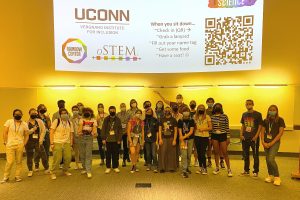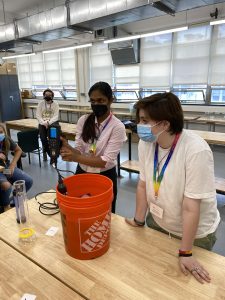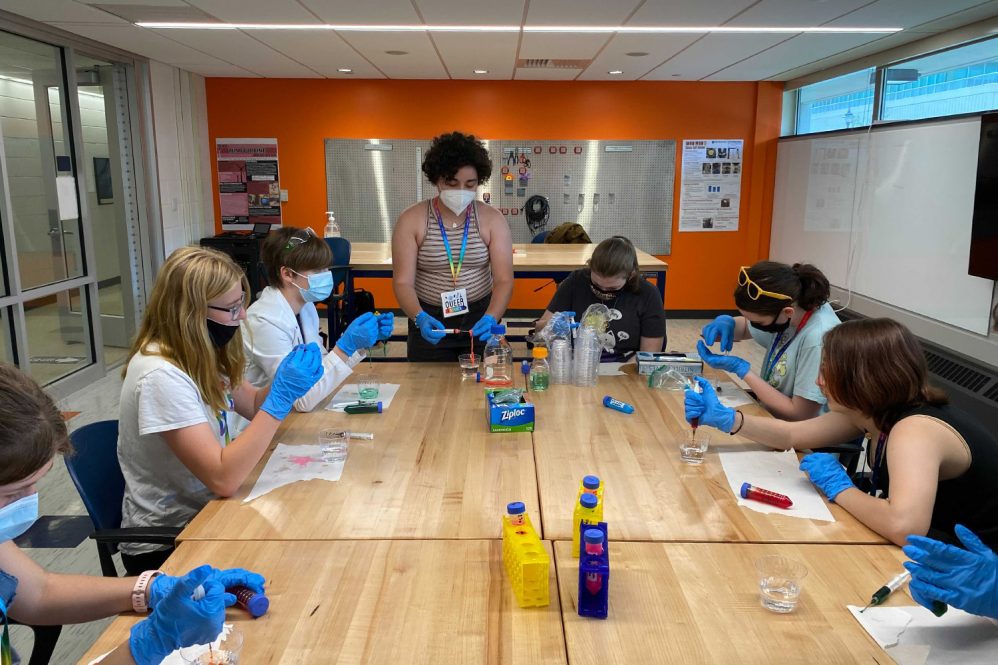Forty-three high school students and 13 members of the UConn community came together to celebrate science – and themselves – in the first Queer Science Conference, held Saturday, June 11, in Storrs.
The one-day, volunteer-driven event connected the students with faculty, staff, and graduate and undergraduate students at UConn who work in STEM disciplines, with the goal of supporting Connecticut youth while offering state-of-the-art laboratory experiences and opportunities for hands-on science demonstrations.
“I wanted to show LGBTQIA+ teenagers that there are people who are like them in all fields of science, technology, engineering, and math, because we don’t get a lot of representation in those fields,” says Anna Marie LaChance ’17 (ENG) ’20 GCCI ’22 Ph.D., who organized the inaugural event with support from the School of Engineering’s Vergnano Institute for Inclusion; the nonprofit organization Out in Science, Technology, Engineering, and Mathematics, or oSTEM; and UConn’s Rainbow Center.
LaChance modeled UConn’s conference on the Queer Science program at the University of Minnesota, which she learned about at an oSTEM conference in 2019.
“I met the ‘Leslie Knope’ of this project, Dr. Julie Johnston, and she told me all about Queer Science, and I was like, UConn needs this – UConn absolutely needs this,” she says. “As soon as I got back from that conference, I started planning in my head, talking to Julie, literally DMing on Twitter, and I started working with the School of Engineering to pull off Queer Science at UConn.”

LaChance began recruiting fellow volunteers from a variety of disciplines, but plans for the in-person event were sidetracked by the onset of the global pandemic in March 2020. In 2021, having completed her doctorate in chemical engineering and then working with the Vergnano Institute, LaChance was able to return to planning for the conference with renewed focus on crafting an event that emphasized both professionalism and networking.
“My number one priority was pulling off some version of Queer Science at UConn,” she says. “I wanted to emphasize people in STEM who had LGBTQ identities themselves. I wanted this to be ‘by us for us,’ in a way, so that students, when they show up to the event, could be surrounded by people who are like them in terms of gender and sexuality. That was really important to me from the get go, only queer people working on this event.”
Just in time for Pride Month, the event was entirely free for participants, who were all high school students ranging in age from 14 to 18.
“We tried to structure it so that we would do a bunch of tours of different lab spaces and other UConn resources in the morning,” LaChance explains, “and then, in the afternoon, sit down, do some science, and get some hands-on experience with real-life science and instruments that real grad students and real faculty use.”
Over the course of the day, the students toured UConn’s Rainbow Center; learned about plants and insects in the UConn Ecology and Evolutionary Biology Greenhouse; and visited the world-class Microbial Analysis, Resources, and Services (MARS) Laboratory.

They caught bugs with Abigail Hayes (they/she), an EEB post-doctoral researcher and entomologist. They learned about water density with doctoral student and ecosystem toxicologist Anika Agrawal (she/they) from the Department of Natural Resources and the Environment, using temperature and salinity to separate a water sample in the colors of the bisexual pride flag. They plotted LGBTQIA+ history on a tree core with Master’s student Jillian Dyer (they/them) and learned how to analyze gas composition from soil samples with research technician Nicolette Nelson (she/her).
“We got people from the biomedical engineering department, people from natural resources and the environment, and people from psychological sciences,” says LaChance. “All of these resulted in really great presentations. All the presenters, the volunteers themselves, not only talked about the science, but also their journey into queerness, their LGBT identities, and how that folded into their STEM identities and affected how they navigate STEM fields.”
The conference made for a day full of connection, and also emotion, for both the volunteers and the participants, who praised the science as well as the inclusive environment the organizers created.
“Throughout the day, people came up to me and were like, ‘I’m crying because I got my first binder,’” says LaChance of the Rainbow Center visit, where students were able to select donated items from the center’s gender-affirming closet. “One student told me, ‘I have never been this open about my gender or sexuality before in my life.’ And that was beautiful.”
With help from the Vergnano Institute for Inclusion, LaChance has already secured funding for next year’s conference, officially making this year’s event the first annual UConn Queer Science Conference.
“It was a day of joy, of connection, of networking,” she says. “and everyone came away from the event with more friends, more community, and more knowledge about STEM subjects, including knowledge about why they should come to UConn.”



